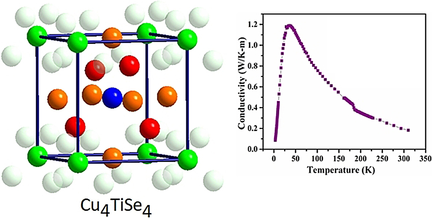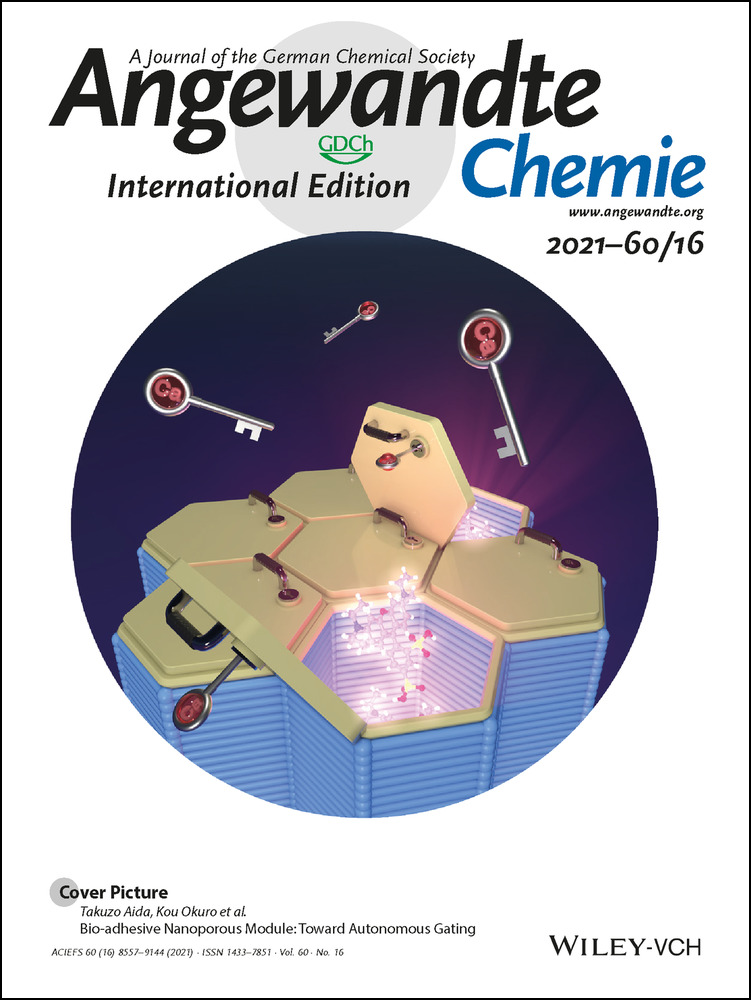Ultralow Lattice Thermal Conductivity at Room Temperature in Cu4TiSe4
Biplab Koley
Department of Chemistry, IIT Kharagpur, Kharagpur, 721302 India
Search for more papers by this authorAchintya Lakshan
Department of Chemistry, IIT Kharagpur, Kharagpur, 721302 India
These authors contributed equally to this work.
Search for more papers by this authorParul R. Raghuvanshi
Department of Metallurgical Eng. and Materials Science, IIT Bombay, Bombay, 400076 India
These authors contributed equally to this work.
Search for more papers by this authorCharanpreet Singh
School of Physical Science, NISER Bhubneswar, Khurda, 752050 India
These authors contributed equally to this work.
Search for more papers by this authorCorresponding Author
Amrita Bhattacharya
Department of Metallurgical Eng. and Materials Science, IIT Bombay, Bombay, 400076 India
Search for more papers by this authorCorresponding Author
Partha P. Jana
Department of Chemistry, IIT Kharagpur, Kharagpur, 721302 India
Search for more papers by this authorBiplab Koley
Department of Chemistry, IIT Kharagpur, Kharagpur, 721302 India
Search for more papers by this authorAchintya Lakshan
Department of Chemistry, IIT Kharagpur, Kharagpur, 721302 India
These authors contributed equally to this work.
Search for more papers by this authorParul R. Raghuvanshi
Department of Metallurgical Eng. and Materials Science, IIT Bombay, Bombay, 400076 India
These authors contributed equally to this work.
Search for more papers by this authorCharanpreet Singh
School of Physical Science, NISER Bhubneswar, Khurda, 752050 India
These authors contributed equally to this work.
Search for more papers by this authorCorresponding Author
Amrita Bhattacharya
Department of Metallurgical Eng. and Materials Science, IIT Bombay, Bombay, 400076 India
Search for more papers by this authorCorresponding Author
Partha P. Jana
Department of Chemistry, IIT Kharagpur, Kharagpur, 721302 India
Search for more papers by this authorGraphical Abstract
Abstract
Ultralow thermal conductivity draws great attention in a variety of fields of applications such as thermoelectrics and thermal barrier coatings. Herein, the crystal structure and transport properties of Cu4TiSe4 are reported. Cu4TiSe4 is a unique example of a non-toxic and low-cost material that exhibits a lattice ultra-low thermal conductivity of 0.19 Wm−1 K−1 at room temperature. The main contribution to the unusually low thermal conductivity is connected with the atomic lattice and its dynamics. This ultralow value of lattice thermal conductivity (kL) can be attributed to the presence of the localized modes of Cu, which partially hybridize with the Se atoms, which in turn leads to avoidance of crossing of acoustic phonon modes that reach the zone boundary with a reduced frequency. Like a phonon glass electron crystal, Cu4TiSe4 could also open a route to efficient thermoelectric materials, even, with chalcogenides of relatively high electrical resistivity and a large band gap, provided that their structures offer a sublattice with lightly bound cations.
Conflict of interest
The authors declare no conflict of interest.
Supporting Information
As a service to our authors and readers, this journal provides supporting information supplied by the authors. Such materials are peer reviewed and may be re-organized for online delivery, but are not copy-edited or typeset. Technical support issues arising from supporting information (other than missing files) should be addressed to the authors.
| Filename | Description |
|---|---|
| anie202014222-sup-0001-misc_information.pdf1.6 MB | Supplementary |
Please note: The publisher is not responsible for the content or functionality of any supporting information supplied by the authors. Any queries (other than missing content) should be directed to the corresponding author for the article.
References
- 1N. P. Padture, M. Gell, E. H. Jordan, Science 2002, 296, 280.
- 2L. D. Zhao, V. P. Dravid, M. G. Kanatzidis, Energy Environ. Sci. 2014, 7, 251–268.
- 3
- 3aC. Chang, M. Wu, D. He, Y. Pei, C.-F. Wu, X. Wu, H. Yu, F. Zhu, K. Wang, Y. Chen, L. Huang, J.-F. Li, J. He, L. D. Zhao, Science 2018, 360, 778;
- 3bL. D. Zhao, S. H. Lo, Y. Zhang, H. Sun, G. Tan, C. Uher, C. Wolverton, V. P. Dravid, M. G. Kanatzidis, Nature 2014, 508, 373–377;
- 3cG. Tan, L. D. Zhao, F. Shi, J. W. Doak, S. H. Lo, H. Sun, C. Wolverton, V. P. Dravid, C. Uher, M. G. Kanatzidis, J. Am. Chem. Soc. 2014, 136, 7006–7017;
- 3dS. Roychowdhury, R. K. Biswas, M. Dutta, S. K. Pati, K. Biswas, ACS Energy Lett. 2019, 4, 1658.
- 4
- 4aM. Samanta, T. Ghosh, R. Arora, U. V. Waghmare, K. Biswas, J. Am. Chem. Soc. 2019, 141, 19505;
- 4bM. K. Jana, K. Pal, A. Warankar, P. Mandal, U. V. Waghmare, K. Biswas, J. Am. Chem. Soc. 2017, 139, 4350–4353.
- 5S. Mukhopadhyay, D. S. Parker, B. C. Sales, A. A. Puretzky, M. A. McGuire, L. Lindsay, Science 2018, 360, 1455.
- 6J. Yang, X. Wen, H. Xia, R. Sheng, Q. Ma, J. Kim, P. Tapping, T. Harada, T. W. Kee, F. Huang, Y. Cheng, M. Green, A. Ho-Baillie, S. Huang, S. Shrestha, R. Patterson, G. Conibeer, Nat. Commun. 2017, 8, 1–9.
- 7T. Takabatake, K. Suekuni, T. Nakayama, E. Kaneshita, Rev. Mod. Phys. 2014, 86, 669–716.
- 8X. Shi, J. Yang, J. R. Salvador, M. Chi, J. Y. Cho, H. Wang, S. Bai, J. Yang, W. Zhang, L. Chen, J. Am. Chem. Soc. 2011, 133, 7837–7846.
- 9H. Liu, X. Shi, F. Xu, L. Zhang, W. Zhang, L. Chen, Q. Li, C. Uher, T. Day, G. J. Snyder, Nat. Mater. 2012, 11, 422–425.
- 10W. Qiu, L. Xi, P. Wei, X. Ke, J. Yang, W. Zhang, Proc. Natl. Acad. Sci. USA 2014, 111, 15031.
- 11B. Li, H. Wang, Y. Kawakita, Q. Zhang, M. Feygenson, H. L. Yu, D. Wu, K. Ohara, T. Kikuchi, K. Shibata, T. Yamada, X. K. Ning, Y. Chen, J. Q. He, D. Vaknin, R. Q. Wu, K. Nakajima, M. G. Kanatzidis, Nat. Mater. 2018, 17, 226–230.
- 12
- 12aS. Ishiwata, Y. Shiomi, J. S. Lee, M. S. Bahramy, T. Suzuki, M. Uchida, R. Arita, Y. Taguchi, Y. Tokura, Nat. Mater. 2013, 12, 512;
- 12bS. Roychowdhury, M. K. Jana, J. Pan, S. N. Guin, D. Sanyal, U. V. Waghmare, K. Biswas, Angew. Chem. Int. Ed. 2018, 57, 4043–4047; Angew. Chem. 2018, 130, 4107–4111.
- 13X. Y. Shi, F. Q. Huang, M. L. Liu, L. D. Chen, Appl. Phys. Lett. 2009, 94, 122103.
- 14M. L. Liu, I. W. Chen, F. Q. Huang, L. D. Chen, Adv. Mater. 2009, 21, 3808–3812.
- 15X. Y. Shi, L. L. Xi, J. Fan, W. Q. Zhang, L. D. Chen, Chem. Mater. 2010, 22, 6029–6031.
- 16J. Y. Cho, X. Shi, J. R. Salvador, G. P. Meisner, J. Yang, H. Wang, A. A. Wereszczak, X. Zhou, C. Uher, Phys. Rev. B 2011, 84, 085207.
- 17E. J. Skoug, J. D. Cain, D. T. Morelli, Appl. Phys. Lett. 2011, 98, 261911.
- 18T. Plirdpring, K. Kurosaki, A. Kosuga, T. Day, S. Firdosy, V. Ravi, G. J. Snyder, A. Harneunggmoung, T. Sugahara, Y. Ohishi, H. Muta, S. Yamanaka, Adv. Mater. 2012, 24, 3622–3626.
- 19R. Liu, L. Xi, H. Liu, X. Shi, W. Zhang, L. Chen, Chem. Commun. 2012, 48, 3818–3820.
- 20X. Lu, D. T. Morelli, Y. Xia, F. Zhou, V. Ozolins, H. Chi, X. Y. Zhou, C. Uher, Adv. Energy Mater. 2013, 3, 342–348.
- 21K. Suekuni, K. Tsuruta, M. Kunii, H. Nishiate, E. Nishibori, S. Maki, M. Ohta, A. Yamamoto, M. Koyano, J. Appl. Phys. 2013, 113, 043712.
- 22Y. Goto, Y. Kamihara, M. Matoba, J. Electron. Mater. 2014, 43, 2202–2205.
- 23A. Suzumura, N. Nagasako, Y. Kinoshita, M. Watanabe, T. Kita, R. Asahi, Mater. Trans. 2015, 56, 858–863.
- 24J. Fan, W. Carrillo-Cabrera, L. Akselrud, I. Antonyshyn, L. Chen, Y. Grin, Inorg. Chem. 2013, 52, 11067–11074.
- 25
- 25aQ. Guo, G. M. Ford, W. C. Yang, B. C. Walker, E. A. Stach, H. W. Hillhouse, R. Agrawal, J. Am. Chem. Soc. 2010, 132, 17384–17386;
- 25bS. C. Riha, B. A. Parkinson, A. L. Prieto, J. Am. Chem. Soc. 2009, 131, 12054–12055;
- 25cS. C. Riha, B. A. Parkinson, A. L. Prieto, J. Am. Chem. Soc. 2011, 133, 15272–15275.
- 26
- 26aD. B. Mitzi, O. Gunawan, T. K. Todorov, K. Wang, S. Guha, Energy Mater. Sol. Cells 2011, 95, 1421–1436;
- 26bE. Osei-Agyemang, G. Balasubramanian, ACS Appl. Energy Mater. 2020, 3, 1139–1144;
- 26cE. Osei-Agyemang, C. E. Adu, G. Balasubramanian, Adv. Theory Simul. 2019, 2, 1900060.
- 27Q. Guo, H. W. Hillhouse, R. Agrawal, J. Am. Chem. Soc. 2009, 131, 11672–11673.
- 28C. Steinhagen, M. G. Panthani, V. Akhavan, B. Goodfellow, B. Koo, B. A. Korgel, J. Am. Chem. Soc. 2009, 131, 12554–12555.
- 29
- 29aM. G. Panthani, V. Akhavan, B. Goodfellow, J. P. Schmidtke, L. Dunn, A. Dodabalapur, P. F. Barbara, B. A. Korgel, J. Am. Chem. Soc. 2008, 130, 16770–16777;
- 29bP. Jackson, D. Hariskos, E. Lotter, S. Paetel, R. Wuerz, R. Menner, W. Wischmann, M. Powalla, Photovolt. Res. Appl. 2011, 19, 894–897;
- 29cJ. Y. Kim, J. Yang, J. H. Yu, W. Baek, C.-H. Lee, H. J. Son, T. Hyeon, M. J. Ko, ACS Nano 2015, 9, 11286–11295.
- 30K. O. Klepp, D. Gurtner, J. Alloys Compd. 1996, 243, 19–22.
- 31P. M. Keane, J. A. Ibers, J. Solid State Chem. 1991, 93, 291–297.
- 32E. M. Chen, L. Williams, A. Olvera, C. Zhang, M. Zhang, G. Shi, J. T. Heron, L. Qi, L. J. Guo, E. Kioupakis, P. F. P. Poudeu, Chem. Sci. 2018, 9, 5405–5414.
- 33L. Pauling, R. Hultgren, Z. Kristallogr. 1932, 84, 204.
10.1524/zkri.1933.84.1.204 Google Scholar
- 34K. O. Klepp, D. Gurtner, Z. Krystallogr. 2000, 215, 4.
- 35G. E. Delgado, A. J. Mora, S. Durán, M. Muñoz, P. G. Gallardo, J. Alloys Compd. 2007, 439, 346–349.
- 36Y. J. Lu, J. A. Ibers, J. Solid State Chem. 1993, 107, 58–62.
- 37G. E. Delgado, A. J. Mora, P. G. Gallardo, S. Durán, M. Muñoz, M. Quintero, Chalcogenide Lett. 2009, 69, 335–338.
- 38A. B. Kehoe, D. O. Scanlon, G. W. Watson, J. Mater. Chem. C 2015, 3, 12236–12244.
- 39L. Palatinus, G. Chapuis, J. Appl. Crystallogr. 2007, 40, 786–790.
- 40V. Petříček, M. Dušek, L. Palatinus, The crystallographic computing system, Institute of Physics, Academy of Sciences of the Czech Republic, 2006, 162, 53.
- 41
- 41aX. Chen, M. Onoda, H. Wada, A. Sato, H. Herbst-Irmer, J. Solid State Chem. 1999, 145, 204–211;
- 41bA. Choudhury, et al., J. Solid State Chem. 2017, 253, 192–201.
- 42M. Patel, A. Chavda, I. Mukhopadhyay, J. Kimband, A. Ray, Nanoscale 2016, 8, 2293–2303.
- 43J. Tauc, R. Grigorovici, A. Vancu, Phys. Status Solidi 1966, 15, 627–637.
- 44M. K. Jana, K. Pal, U. V. Waghmare, K. Biswas, Angew. Chem. Int. Ed. 2016, 55, 7792–7796; Angew. Chem. 2016, 128, 7923–7927.
- 45H. Lin, et al., Angew. Chem. Int. Ed. 2016, 55, 11431–11436; Angew. Chem. 2016, 128, 11603–11608.
- 46P. Hohenberg, W. Kohn, Phys. Rev. 1964, 136, A864–871.
- 47W. Kohn, L. J. Sham, Phys. Rev. 1965, 140, B1133–1138.
- 48G. Kresse, J. Hafner, Phys. Rev. B 1994, 49, 14251–14269.
- 49J. P. Perdew, K. Burke, M. Ernzerhof, Phys. Rev. Lett. 1996, 77, 3865–3868.
- 50A. Togoand, I. Tanaka, Scr. Mater. 2015, 108, 1–5.
- 51
- 51aA. Bhattacharya, J. Mater. Chem. C 2019, 7, 13986–13992;
- 51bA. Bhattacharya, J. Phys. Condens. Matter 2020, 32, 175502.





